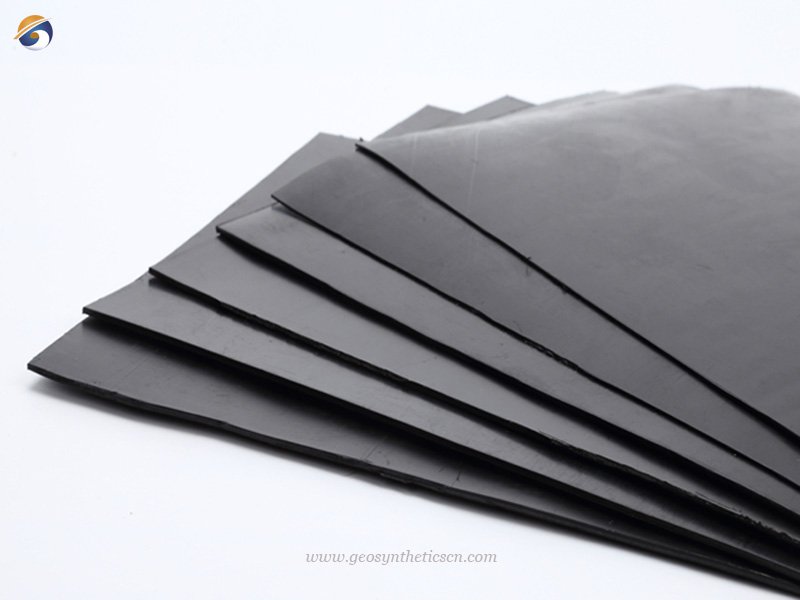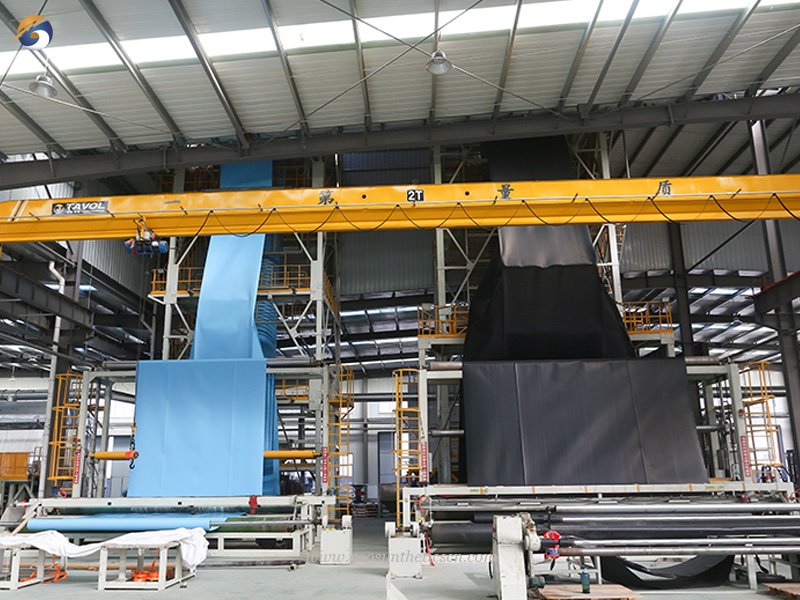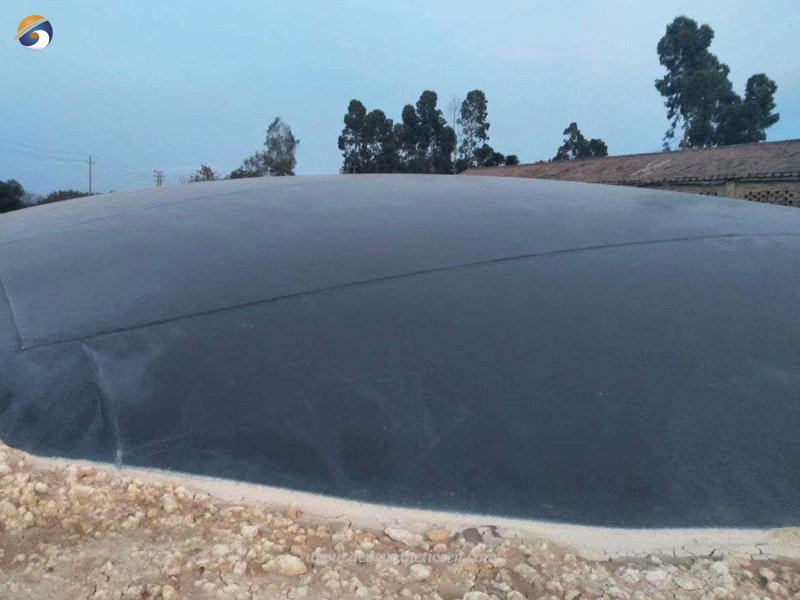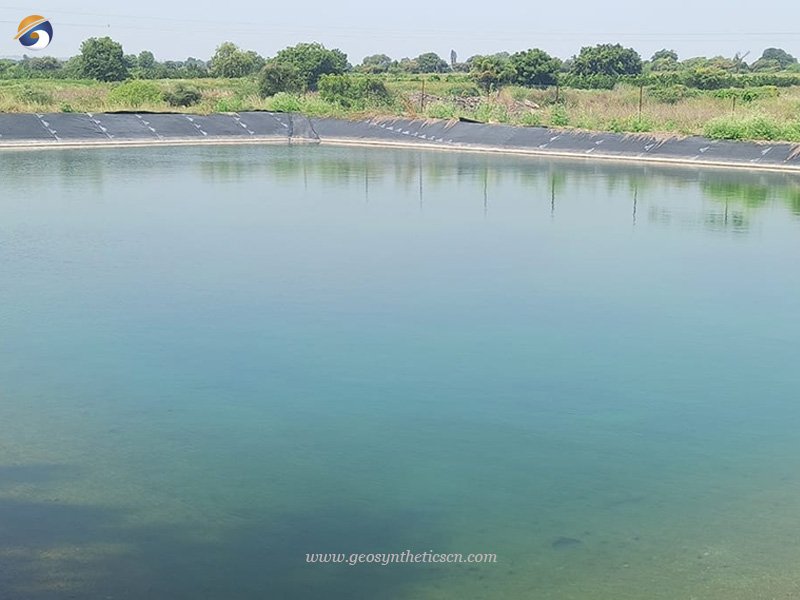What is a geomembrane liner? According to Wikipedia, a geomembrane is very low permeability synthetic membrane liner or barrier used with any geotechnical engineering related material so as to control fluid (liquid or gas) migration in a human-made project, structure, or system.
Geomembrane liner inlcudes smooth geomembrane, textured geomembrane and composite geomembrane. The smooth geomembrane is available in three different colors such as black, white and green.
Geomembrane liner is ideal for waste, water, aquaculture, energy, mining, industrial and civil engineering, etc.
1.Raw Materials for Geomembrane Liner
Geomembrane liner usually refers to polyethylene (PE) geomembrane. The raw material includes polyethylene resin, adding carbon black, anti-oxidant and anti-aging and UV-resistance component. Its raw material are polyethylene, low-density polyethylene, linear low-density polyethylene and high-density polyethylene, etc. Among them, high-density polyethylene (HDPE) is the ideal material to manufacture geomembrane for anti seepage engineering applications.
1.1 Polyethylene
Polyethylene (PE) is one of the varieties with the simplest molecular structure in the resin. It is rich and cheap. The polyethylene has excellent electrical insulation and chemical stability. Since its inception, it has developed rapidly.


1.2 Low-density polyethylene (LDPE)
It is milky white wax particles, tasteless, odorless, non-toxic and flammable. It has good flexibility, ductility, transparency, and cold resistance. The chemical properties are relatively stable, and it can resist acids, alkalis and general organic solvents below 60 °C. At the same time, it also has good electrical insulation properties.
1.3 Linear Low-density Polyethylene (LLDPE)
Linear low-density polyethylene is a new type of second-generation polyethylene plastic. Compared with low-density polyethylene, it has the characteristics of excellent performance and significant economic benefits in production.
LLDPE has excellent stress cracking resistance and electrical properties, high heat resistance, excellent impact strength, tensile strength and bending strength, etc.
Films made of LLDPE have higher impact strength and tear strength than LDPE.
1.4 High-density Polyethylene (HDPE)
High-density polyethylene is the white granule or powder material, it heatures tasteless, odorless, non-toxic and flammable.
High-density polyethylene has good cold resistance. The service temperature can be as high as 100 ℃ and as low as -70 ℃.
Due to high crystallinity (80%~90%), high relative density (0.941~0.965), and better mechanical properties, HDPE has better poperties than low density polyethylene.
HDPE also has better wear resistance and good chemical stability. HDPE is almost insoluble in any organic solvent at room temperature. It is resistant to corrosion of various acids, alkalis and various salt solutions.
Water absorption and water vapor permeability are very low. However, the aging resistance is relatively poor. Anti-oxidants and light stabilizers need to enhance its performance.
2. Geomembrane Manufacturing Processes
2.1 Blow Molding Process for Geomembrane Manufacturing
Blow molding is the principle to manufacture geomembrane. The polymer and additives are put into the externally heated extruder. And then conveyed, compressed and metered by the screw rotating the extruder.
After melting and plasticizing the material, a tube blank in a molten state is extruded from an annular die. Under the action of air, it gradually expands. At this time, the outside of the tube blank is cooling down.
Force pushes into one end of the tube blank to make it move forward at a constant speed. A continuous cylindrical geomembrane can be obtained. The cylindrical geomembrane is open, flattened and rolled up to obtain a membrane (sheet) geomembrane.
Geomembrane manufacturing equipment for blow molding includes extruder, machine head (mold), cooling air ring, herringbone splint, traction roller, and winder, etc.
Blow molding is blow molding used to manufacture , HDPE geomembrane
the temperature of the melt discharged from the die is above 180°C.
Even if it is cooled to 60°C, the temperature difference is above 120°C. Quickly cooling down to improve production efficiency, internal and external cooling of the film bubble combine together. External cooling still uses wind ring and air cooling. Internal cooling includes air cooling and water cooling.
Before coiling, the blow-molded geomembrane needs to undergo a series of steps, including being cut open, flattened, and then coiled in a single layer. This is not just for the convenience of laying, more importantly, the geomembrane itself should not have creases. Geomembrane with creases, where the tensile strength and tear strength are very low, the thicker the thickness of the geomembrane.
Geomembrane is thick and the length is long, it is generally actively coiling into the roll with a core. The core is generally made of plastic. Yes, it is possible to secure the geomembrane to the core using iron nails or a strong pressure-sensitive tape. However, it is important to consider the specific requirements and recommendations for the installation of geomembranes in your application.
When using iron nails, it is should be corrosion-resistant and suitable for the specific environmental conditions of the installation site. This is important to maintain the integrity and longevity of the geomembrane.
When the core rotates, the geomembrane can rool smoothly.


2.2 Calendaring Process for Geomembrane Manufacturing
The heated and plasticized thermoplastic is fed through the gap between counter-rotating rollers, which transforms it into a film of predetermined dimensions. This film is utilized for geotechnical materials.
The polymer material used in the calendared geomembrane liner mainly refers to classification of polyethylene and calendared geomembranes. he calendaring process is utilized to produce various types of geomembranes, including single-layer polyethylene geomembranes, double-layer polyethylene composite geomembranes, and sandwich polyethylene composite geomembranes. Here is a description of the calendaring process:
- Preparation: The process begins with the preparation of raw materials, typically thermoplastic polyethylene. The polyethylene is heated and melted to a suitable temperature for processing.
- Feeding: The molten polyethylene is then fed into a series of rollers in the calendaring machine. These rollers are often made of metal and are counter-rotating.
- Calendering: As the polyethylene passes through the gap between the rollers, pressure is applied to shape and compress the material. The rollers’ speed, temperature, and pressure are carefully controlled to achieve the desired thickness and smoothness of the geomembrane.
- Cooling: After being shaped by the rollers, the calendared geomembrane undergoes a cooling process. This can involve passing the material through a cooling chamber or using cooling rolls to rapidly cool and solidify the geomembrane.
- Winding: Once cooled and solidified, the calendared geomembrane is wound onto rolls for storage, transportation, and further processing.
3. Performance of Geomembrane
3.1 The performance of low-density polyethylene geomembrane liner
The density of geomembranes, including those made from low-density polyethylene resin (PE-LD), linear low-density polyethylene resin (PE-LLD), ethylene copolymers, and other raw materials, typically falls within or below the range of 0.939 g/cm³.
Low-density polyethylene geomembrane applications Reservoirs, channels, pools, dams, artificial lakes, culverts, tunnels, basements of buildings, etc.
Low-density polyethylene (LDPE) geomembranes possess several characteristics such as cold resistance, softness, ease of forming and processing, good weldability and affordability.
However, they also have certain limitations, including lower strength, susceptibility to punctures and damage, lower elongation deformation rate, poor resistance to environmental stress cracking, higher water permeability, and higher air permeability compared to high-density polyethylene (HDPE) geomembranes.
3.2 The performance of Linear Low-density Polyethylene (LLDPE) Geomembrane liner
Geomembranes produced with linear low-density polyethylene resin (PE-LLD), and geomembranes with a density of 0.939g/cm3 or less.
Linear low-density polyethylene geomembrane is usually ideal for reservoirs, channels, pools, dams, artificial lakes, culverts, tunnels, basements of buildings, etc.
3.3 The performance of linear low-density polyethylene geomembrane
Linear low-density polyethylene geomembrane is a new type of PE after LDPE and HDPE.
LLDPE geomembranes have many applicable fields including reservoirs, channels, pools, dams, artificial lakes, culverts, tunnels and basements of buildings.
Their properties include flexibility, ease of installation, UV radiation resistance and chemical substances. LLDPE geomembranes provide effective containment and barrier functions, helping to prevent seepage and leakage in these water-related and underground structures.
3.4 The performance of High-density Polyethylene (HDPE) Geomembrane Liner
Medium-density polyethylene resin (PE-MD) and high-density polyethylene resin (PE-HD) are often the raw materials for geomembranes production. The density of geomembrane is often 0.940g/cm3 or above.
High-density polyethylene geomembrane has many applications including reservoirs, channels, pools, dams, artificial lakes, culverts, tunnels, building basements. It is ideal for anti-seepage and coverage of the bottom of landfills, tailings, and hazardous waste, etc.
High-density polyethylene (HDPE) geomembranes have high strength and excellent heat resistance. In particular, HDPE geomembranes made from medium-density polyethylene (MDPE) exhibit good resistance to environmental stress cracking. These geomembranes are ideal for environmental protection industries, specifically in challenging environments such as landfill sites. The superior resistance to stress cracking is an important characteristic in preventing leakage and ensuring environmental containment.
HDPE geomembranes also offer advantages such as good weldability, puncture resistance, and a moderate price point. However, compared to linear low-density polyethylene (LLDPE) geomembranes, HDPE geomembranes tend to be harder and have slightly lower adhesive performance. Nonetheless, they remain widely used in various applications requiring robust containment and barrier properties.


4. Geomembrane Characteristics
The service life is the main factor determining the life of engineering. The engineering environment is extremely complex, including factors such as force, heat, medium and time.
These factors usually act on the geomembrane in combination. The result is an irreversible impact on the inherent properties of the engineering material. So the geomembrane should have the following characteristics.
4.1 Water resistance
Geomembranes are often in contact with water. The macromolecules that make up the geomembrane do not contain hydrophilic groups such as amide groups and ester groups. They are incompatible with water and will not undergo hydrolysis reactions with water. Water absorption,
The water permeability is extremely low. For example, the HDPE geomembrane water absorption rate of is less than 0.3%. Its water vapor transmission rate is less than 10-13cm/s.
In the geomembrane manufacturing process, relevant additives is important. The water resistance of these additives becomes the main factor affecting the water resistance of these geomembranes.
4.2 Acid and alkali resistance.
In the anti-leakage projects, the media that the geomembrane meets are mostly various acid-base solutions. Polyethylene geomembrane can resist most acids,
Corrosion by alkali and salt solutions, but their resistance to hot, concentrated oxidizing acids is limited. Like water resistance, the improper selection of various additives will seriously affect the acid and alkali resistance of the geomembrane.
4.3 Resistance to active substances
In the anti-seepage treatment of sewage ponds, sewage treatment plants, landfills and other projects, geomembranes will inevitably meet surfactants. Ordinary polyethylene geomembranes have extremely poor resistance to surface activity. The smooth high-density polyethylene geomembrane for environmental protection has a strong ability to resist surfactants.
4.4 Resistance to organic solvents
In the anti-leakage projects of breweries, oil refineries, organic chemical plants, etc., the geomembrane meets various organic solvents. The polyethylene geomembrane is below 60 ℃ and can resist the erosion of most organic solvents.
4.5 Resistance to metal ions
Metal ions are more or less in the water. In anti leakage projects involving tailings impoundments and electroplating plants, it is common to encounter high metal particle concentrations. These metal ions can originate from the tailings or wastewater generated in these industrial processes. The specific metals present can vary depending on the type of operation and the specific chemicals used.
4.6 Resistance to micro organisms
Micro organisms are ubiquitous, in water, in soil, on animals and plants.
traces of fungus. Among synthetic polymers, micro organisms do not pose a threat to polyethylene geomembranes.
4.7 Aging resistance
The aging resistance of polymers is the most important feature that affect the service life of the material. Most common causes and forms are the effects of light, heat and oxygen. They can lead to photo (oxygen) aging and thermal (oxygen) aging.


4.8 Mechanical properties
The splicing seams of geomembranes will also encounter forces such as shearing and peeling. Geomembranes is ideal for soft anti-seepage Leakage material. Although it is often can’t bear all the loads generated by the project. Heomembrane has good mechanical properties, which will undoubtedly be very beneficial to anti-seepage projects.
4.9 Creep resistance
Material creep refers to the deformation of materials increases gradually with the growth of time when the force is constant. Creep characteristics are one of the most important characteristics of synthetic materials and the key to long-term application of materials.
4.10 Construction performance
The construction performance of geomembrane refers to the difficulty of laying geomembrane, the difficulty of splicing and reliability. The specification design of geomembrane should consider the needs of different projects. The splicing of geomembrane is currently a very mature technology.
GEOSINCERE specializes in manufacturing geomembrane and geosynthetics products and solutions to worldwide customers since 2007. Our high quality products include geomembranes, geotextiles, geogrids, geocells, geosynthetic clay liners, and drainage boards, etc.
GEOSINCERE offers both high quality geosynthetic products but also professional design and installation service. OEM, ODM, custom development and fabrication are also available. If you have any questions or inquiries, please fill and submit the following form, we will reply as soon as possible.
Thanks for reading.





